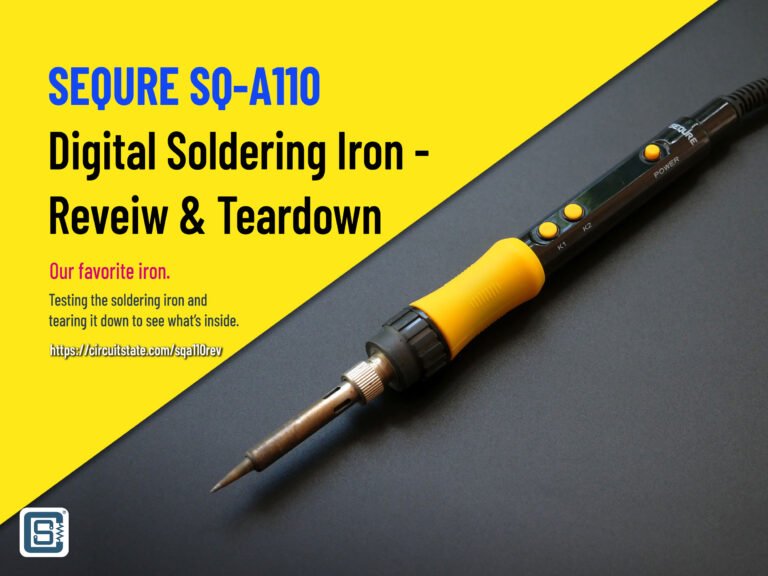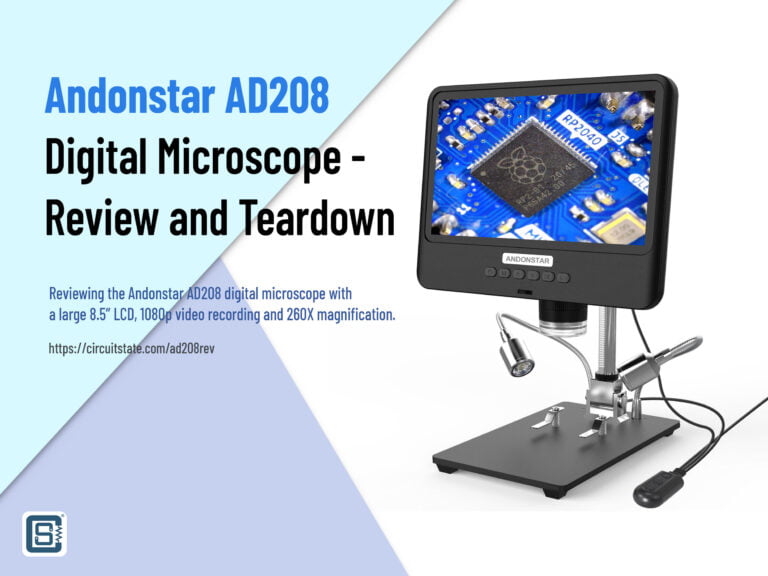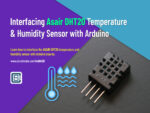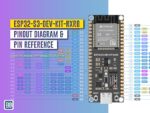Atten ST-2065D 65W Digital Temperature Controlled Soldering Iron – Review and Teardown
Unboxing, review, performance test, and teardown of Atten ST-2065D 65 watts portable and adjustable digital temperature-controlled soldering iron.

Shenzhen Atten Technology Co., Ltd. or in short Atten, is a Chinese manufacturer of soldering equipments. Today we have their ST-2065D digital temperature-controlled soldering iron for review. It is a 65W portable (no station) and adjustable iron that supports T900 series (Hakko 900M series compatible) tips and is available in both 110V or 230V options. This is the first Atten product we are trying out. We bought it from Samux Precision Technology, an official Atten distributor in India, for Rs.2671 with taxes. We will first talk about the ergonomics of the product. Then we will test its performance and disassemble it to have a look inside. Let’s begin with specifications.
Specifications
| Specification | Value |
|---|---|
| Power | 65W |
| Input voltage | 110VAC/230VAC ±10% 50Hz/60Hz |
| Output voltage | 24VAC |
| Temperature range | 80~480°C (176 ~896°F) |
| Temperature offset range | ±50°C (±90°F) |
| Temperature stability | ±2°C at idle temperature |
| Tip to ground resistance | <2Ω |
| Tip to ground potential | <2mV |
| Temperature accuracy | ±10°C |
| Heating element | Four-core PTC heater |
| Soldering tip | T900-B (comes with it) |
| Net weight | 195±10g |
The ST-2065D has four more siblings that look alike – ST-2080D (80W), ST-2150D (150W), and their non-LCD versions ST-2080 and ST-2150.
Features
- Selectable Celcius (°C) or Fahrenheit (°F) temperature units.
- Automatic sleep after 10 minutes of inactivity.
- Automatic shut down after 20 minutes of inactivity.
- LCD display for temperature reading.
- Microcontroller-based PID system for temperature control.
- Manual temperature display compensation.
- Single push-button with backlight for ON/OFF control and heating indication.
- Two soft push-buttons for increasing and decreasing temperature.
- 9 selectable temperatures are saved on memory and easily selected by push-buttons.
- PTC-based four-wire ceramic integrated heater and temperature sensor for faster heating and accurate temperature control.
- Automatic fault detection.
- Made of anti-static materials for ESD-Safe work. The tip is also earthed.
- Uses low-cost T900 series soldering tips.
- Lead-Free, ESD-SAFE, FCC, CE, ROHS, and PAHS approvals.
In The Package
- 1 x Soldering Iron with T900-B bit
- 1 x Soldering iron stand
- 1 x Instruction manual
- 1 x QC certificate







Build Quality
The overall build quality of ST-2065D is excellent. The plastics and metals used are of good quality. The cable is a three-core one with a Type-E plug rated for 16A at 250V. The cable is attached to the device with a strain relief sleeve. The three push-buttons are made of soft rubber or silicone and have very good clicky feedback. The ST-2065D comes with a T900-B rounded bit.












Ergonomics
This is what we are disappointed about. The ergonomics of this iron are very bad. You can create a product with state-of-the-art processes using good-quality materials and still end up producing a very bad product in terms of usability. To begin with, the cable used in the Atten iron is thick, heavy, and not flexible. A soldering iron is a hand tool. It has to move a lot in tandem with the operator’s hand. The thick cable limits the movement of iron and adds extra weight to the product. You won’t even be able to twist the iron, like when you clean the tip, without exerting a good amount of force.
The body of the ST-2065D iron is a two-piece plastic that has a smooth matte finish. There are no non-slip rubber or silicone sleeves that are usually found on the cheapest irons. So if your hands are going to sweat, you will have a difficult time holding this iron comfortably. The materials used, design and construction make it a relatively heavier iron with 195g±10g. That’s like holding a smartphone with your fingertips. Compared to this, the Noel 90W digital iron we previously reviewed has great ergonomics and feel-in-the-hand.


The design of the iron is pretty outdated. Checking their discontinued product sections, Atten indeed had better designs in the past. But they somehow ended up adopting a worse design than an improved one. Maybe they wanted to look different in the crowd. The Atten ST-2065D looks more like the cheapest irons in the market with screws holding the metal parts. Only the soldering end of the soldering iron gives some peace of mind. It is easy to remove and insert the tip with a single nut keeping the metal jacket in place.
But whatever that is, the Atten ST-2065D looks exactly the same as Multicomp Pro MP740062/MP740060 soldering iron models. All the specifications and designs are the same. Both irons only have the cosmetic difference of the logos they bear. Oh and also, Atten has at least a website with more relevant product information than Multicomp Pro (could Atten be OEM of Multicomp Pro, Who knows). So you could consider this post as a review of Multicomp Pro’s MP740062 and MP740060 irons as well.
Another bummer of Atten ST-2065D is that LCD is not backlit. So if you are using the iron in a not-so-bright environment, you will have a hard time reading the temperature values. The same is the case when you try to read the display against bright lights. The reflective LCD cover will obscure what the LCD is showing. Atten really could have added a single LED backlight. Apart from that, the three push buttons have a good clicky feel and the power button has an integrated LED indicator. Changing the temperature is very easy and the nine selectable preset temperatures can save you time.
The iron comes with a very basic soldering stand which you can throw out of the window with zero hesitation. If you want to buy a compatible stand, the manufacturer has the S-11 model.
Operation
When you plug the iron into the mains, it will remain off indicating OFF on the display. But just before that the display also shows U036 which we think is a software version code. Once the power is on you have to press the power button once to turn on the heating. The iron will start heating to the temperature you have previously set. That means the iron will remember the temperature setting even after a power cycle. You can switch between the preset temperature by pressing the + or – buttons. The digit on the top right corner of the display will indicate which temperature you have currently set. The list will roll back if you keep pressing one of the buttons.
The Atten ST-2065D has automatic sleep and shutdown modes. When you don’t use the iron (when you don’t move the iron, precisely), it will reduce the temperature to the lowest level (sleep mode) and shut down if not used for longer. The sleep mode timeout is 10 minutes and for shutdown mode, it’s 20 minutes. There must be a motion or vibration sensor inside the iron to detect movements. We will find out after opening the iron.
You can press and hold the power button to enter the settings mode. The display will blink twice to indicate that you are in the settings mode. The first setting is the temperature. You can change the value of the preset temperature you are currently in. For example, if you entered the settings mode when temperature preset 3 was active, then you will be able to adjust the value of preset 3. You can long press the power button to adjust the temperature at a larger increment than 1°C.
The next setting is the temperature sensing compensation. The tip temperature and displayed temperature can be different in the practical case. So you can add an offset to the displayed temperature to compensate for the differences. You can have positive or negative values. A 00d will appear on the display at this time. The temperature offset you set will apply to all temperature presets. The maximum compensation value is 50°C.
The next setting is the sleep mode activation. The display shows SLP at this time and the current state of the feature. SLP1 indicates sleep mode on, and SLP0 indicates off. Pressing the power button again will save the settings and exit to normal working mode.
Performance
Here will test the iron for its real performance than what is given in the specs sheet. It took around 25 seconds for the iron to reach 300°C. But this does not mean the iron tip was at 300°C. The Atten ST-2065D can only measure the temperature inside the heating element and not the iron tip. This means, there will be some latency between the heating element and the iron tip reaching the required temperature. This is the disadvantage of this kind of soldering iron that can not measure the tip temperature. The best you can do is to add a compensation value to make up for the difference.
Reaching higher temperatures such as 480°C will take some time since the maximum output power of the heating element is only 65W. The actual temperature on the tip and what is shown on the display were off by around 20 to 50°C with the compensation value set to 0. We measured the tip temperature using a Thermocouple connected to a digital multimeter. After setting the compensation value to -50°C, the tip temperature was around 280°C for a displayed 300°C, which is fairly good.
Keeping the idle temperature to the desired value is not the only job of a temperature-controlled soldering iron. It has to also maintain the temperature when heat is drawn away. The iron will only be able to do this within its power limitation. We tried setting the temperature to 300°C and melting the solder on a PCB with a large ground plane. The temperature dropped drastically to around 200°C and remained there while the tip was touching the ground plane. The temperature was just enough to melt the 60/40 solder. Meanwhile, the display was still showing 300°C. This means the iron is bad at sensing large temperature drops on the tip and thus is not able to supply more heat when needed. That results in bad thermal recovery (the ability to reattain the set temperature).
Teardown
The tip and the cylindrical metal jacket can be removed easily by unscrewing the nut. You can now see the heating element which is protected by another metal shroud that is secured to the main plastic body with the help of three Philips screws. By removing these screws and with a little force, you can detach the remaining metal part.





The metal base has a pin on the bottom side. This pin connects to a socket on the main PCB that connects to the Earth pin. This ensures a low resistance path to mains Earth from the tip of the iron, making it ESD-Safe. The main plastic body is a two-piece plastic snapped together and a screw on the back side for extra rigidity. Remove the screw and separate the two plastic halves with the help of a plastic pry tool. Make sure you don’t exert too much force on the heating element. It is simply soldered to the board directly. You can easily break the pins with a little force.






Once the plastic pieces are separated, everything will come off easily. The PCB is similar to what we have seen on the Noel 90W digital iron. It has components on both sides. The design consists of a non-isolated buck converter, Triac, voltage regulator, microcontroller, buttons, and an LCD. The buck converter is based on LNK302DG from Power Integrations. With a maximum input voltage of 700V, it can convert line voltages to lower DC voltages such as 12V. We measured 5V DC on the VCC line. An EL357N optocoupler is used for feedback to the buck converter.

The heater driver is based on BT134S-600E (TO-252 SMD version) Triac which can handle voltages up to 600V and a continuous RMS current of 4A. The T1 of the Triac is connected to Line. The Gate pin is connected to an S8050 transistor (code Y1) which is driven by the microcontroller. T2 of the Triac is connected to one end of the heater and the other end is connected to Neutral as found in a typical Triac drive.
The heater has a two-terminal Thermocouple output. The pins are connected to a small amplifier based on LMV321IDBVR (SOT-23-5, RC1F) rail-to-rail operational amplifier. The output of the amplifier goes to an ADC pin of the microcontroller for measuring the temperature.
The microcontroller used is a Nuvoton N76E003AT20 which has an 8-bit 8051 core. It has an internal 16MHz high-precision RC oscillator and comes in a TSSOP20 package. The ADC is 12-bit and has 8 channels. So we assume the temperature measurement also has a 12-bit precision. There is also an SWD header for programming the microcontroller.







Verdict
Let’s list the pros and cons of the Atten ST-2065D soldering iron before we conclude this review.
Pros
- Great build quality and excellent durability.
- Universally compatible soldering bit and heating element.
- Fast heating with an adjustable temperature range of 80 to 480°C.
- 9 quick selectable temperatures.
- Manual temperature value compensation.
- Automatic sleep and shutdown modes.
- ESD-Safe (materials and tip earthing).
- Easily portable.
- FCC, CE, ROHS, and PAHS approvals.
Cons
- No backlight for LCD.
- Bad ergonomics (no non-slip grip and non-flexible cable).
- Somewhat outdated design.
The Atten ST-2065D is definitely a well-built soldering iron with many features. But it falls short of our practical usability expectations. We can not recommend this iron to the average hobbyists, makers, or engineers with mixed uses. But if you are a person who needs a rugged soldering iron such as automobile technicians or electricians, we would highly recommend this iron for its build quality and ruggedness.
The ST-2065D is not available directly in any e-commerce store. If you want to buy one, contact Samux Precision Technology on their business phone number – +91 7990161883. This number also has WhatsApp on it.
Alternatives
There are definitely similar or better irons that you can choose from. We previously reviewed the Noel 90W soldering iron which has a good build quality and great ergonomics, and you get it for around Rs.1300. But it, unfortunately, does not have a temperature sensing function. If you can spend around Rs.2000, you can get the SEQURE SQ-A110 110W iron. If you still have space left on your table, you could also consider buying a digital soldering station such as the T12 compatible ones listed below.
- SEQURE SQ-A110 110W Digital Display Soldering Iron
- Noel 90W Digital Soldering Iron
- Multicomp PRO MP740063 Soldering Iron
- OSS Team T12-D 72W Digital Soldering Station
- OSS Team T12D+ Digital Soldering Iron Station (72W)
- MECHANIC T12 PRO Digital Temperature Controlled Soldering Station
- OSS Team T12-X Digital Soldering Station
- Sunshine SS-928D Digital Soldering Iron
Links
- Atten ST-2065D – Product Page
- Atten ST-2065D User Manual – PDF
- Buy Atten ST-2065D from Samux
- Watch how Atten soldering irons are made – YouTube
- Noel 230V/90W Digital Temperature Controlled Soldering Iron Review & Teardown
Short Link
Short URL to this page: https://circuitstate.com/attenst2065d





Hi,
I have bought this model, but I have received the 110v 60hz version in place of the 220v 50hz one. Which components should be changed in order to use it Europe?
Thank you
We are not sure which components have to be changed. The buck converter used in the power supply section can actually accept voltages in the range of 85-265 VAC as per the LNK302DG application note. But there must be some design choice that limits this range to either 110V or 220V. Otherwise, the manufacturer would never have to specify the exact working voltage for the iron. Instead, they could simply label it as 110-220 VAC.